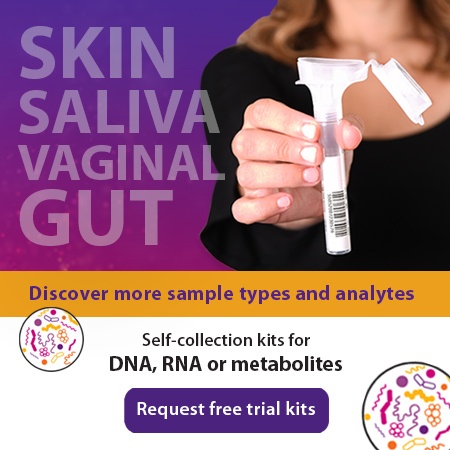2021-09-27
This year the International Human Microbiome Consortium Congress (IHMC) brought together the most renowned scientists and researchers in the Microbiota field. Adapting to a digital conference platform the congress, spanning across July 27th to 29th, presented three full days of lectures gathering specialists from all over the world to give a program on the latest scientific and industry developments including areas like transcriptomics, IBD, metabolomics, nutrition and translational research. Here we discuss some of the highlights from presentations given by leading microbiome scientists at IHMC.
Expanding Gut Microbiome Insights: Transcriptomics
Gut microbiome research integrating a variety of sample types from multiomic projects is establishing new understandings of the gut microbiome from functional and taxonomic perspectives. However, multiomic sample collection limits the viability of these projects. Focusing on the challenges of collecting DNA and RNA using the same collection device, Dr. Brice Le Francois of DNA Genotek presented “Expanding Gut Microbiome Insights: Transcriptomics.”
With vastly different molecular properties DNA and RNA require stabilizing solutions that are only suitable for one or the other. For example, high concentration salt solutions, like RNAlater, perform well with RNA, and guanidinium based solutions are better for DNA. Keeping these limitations in mind, Dr. Le Francois and his team at DNA Genotek developed a prototype collection device capable of capturing both DNA and RNA, stabilizing them at the site of collection.
In collaboration with Illumina, the groups created a microbiome probe pool that selectively depleted non-mRNA within the sample. Testing the sampling device with mock communities the prototype collection device’s preliminary data showed DNA and RNA stability for up to 14 days at room temperature while having little impact on microbiome profiles. Opening the transcriptome to researchers by enabling multiomic analysis in complex stool samples, this device will help the characterization of the functional and taxonomic profiles of the gut microbiome.
Expanding Gut Microbiome Insights: Metabolomics
Gut metabolomics is a growing area of interest as researchers seek to reveal microbial functions through the metabolome of the microbiome. Capturing samples suitable for metabolomics is difficult as it requires inhibiting all microbial activity or ongoing microbial activity within samples that would rapidly change the composition of the metabolome at room temperature. The gold standard for metabolomic sample has been flash freezing to -80 C. This method, however, is not suitable for at-home collection. While cold-chain shipment is one alternative to flash freezing, the potential for temperature fluctuations can dramatically alter sample integrity. Seeing the need for improved metabolomic sample collection, Dr. Olle de Bruin and his team at DNA Genotek created the OMNImet•GUT device, to collect and stabilize metabolomic human fecal samples at the site of collection.
Using Liquid Chromatography / Mass Spectrometry (LC/MS) on untargeted metabolomic assays with the OMNImet•GUT device, metabolomic profiles of raw samples were preserved with high fidelity and sustained metabolite stabilization for 7 days at room temperature when compared to flash frozen samples. Furthermore, observing targeted assays for short chain fatty acids the OMNImet•GUT showed short chain fatty acid concentrations remained stable for 14 days. For example, butyrate, a common by product of microbes, remained at a consistent concentration at various time points from OMNImet•GUT samples while room temperature samples showed a dramatic increase in butyrate over a few days, thus indicating ongoing microbial activity within the sample.
Collaborating with Inova Children’s Hospital and Metabolon, OMNImet•GUT was used in a hospital based field test with matched infant stool samples that were flash frozen and stored in OMNImet•GUT devices for four days at ambient temperature. In PCA plots of the 1064 metabolites detected, both frozen and OMNImet•GUT samples from the same individual clustered closely together. The consistency between samples showed the reliability of both methods with OMNImet•GUT preforming similar to flash frozen while capturing time dependent metabolic changes occurring in the infant gut microbiome.
Gut Microbiome Recovery in Ulcerative Colitis Patients
Dr. Claudia Herrera opened the Irritable Bowel Disorder series with her presentation: “Gut Microbiome Recovery in UC Patients on Long Term Remission.” While the origin of ulcerative colitis (UC) is still unknown, clinical data supports the association of UC with dysbiosis, a change in balance between beneficial microorganisms and potentially pathogenic ones. For example, short chain fatty acid producing bacteria are seen to decrease in UC patients while species of Fusobacterium and Enterobacteria increase in abundance. Periods of dysbiosis in UC patients are shown to correlate with the severity of gut inflammation and from this basis Dr. Herrera hypothesized UC patients reaching longer periods of remission have more beneficial gut microbiota compositions than active or short-term remission patients.
Evaluating the gut microbiomes of UC patients Dr. Herarrara split patients into four groups: long-term remission, short-term remission, active UC flare, and healthy controls. Over a period of 24 months the patients were followed and 16S amplicon sequencing was preformed on fecal samples to determine the composition and diversity of the microbiome. In healthy controls and long-term remission patients the microbiome composition had greater diversity compared to short-term or active UC patients. Similarly, microbiome compositions of healthy and long-term remission patients clustered closely together while short-term remission or active microbiome compositions clustered separately. Looking at taxonomic differences Dr. Herrera identified higher Akkermasia abundance in healthy and long-term remission patients and a higher abundance of Streptococcus and Escherichia in short-term remission and flare patients. Evaluating these key microbes at the end of the study showed that patients with a detectable level of Akkermansia had a higher probability of remaining flare free.
Diet and Microbiome Health in the Elderly
The gut microbiome plays a key metabolic role in nutrition and Dr. Paul O’Toole from the University College Cork opened the series on nutrition presenting his research on “Diet and Microbiome Health in the Elderly.” Both culture-dependent and culture-independent studies have shown older populations have a gut microbiome composition different than younger populations. To better understand these differences Dr. O’Toole and his team worked with 30 participants, including 20 long-term care patients vs 10 healthy seniors as controls, giving prebiotic supplements to observe changes within the microbiome. All thirty participants experienced changes within their microbiomes with long-term care patients demonstrating the most significant change.
Concurrently with this study, Dr. O’Toole contributed to the NU-AGE study, also known as New dietary strategies addressing the specific needs of elderly population for a healthy ageing in Europe study, to observe diversity and taxa difference in elderly populations. Over 1250 elderly patients were switched onto the Mediterranean diet to observe the impact of a high nutritional content diets in aging populations. A number of significant taxa changes were identified. Certain beneficial microbes such as Faecalibacterium prausnitz, Eubacterium and Roseburia, increased in abundance while negative taxa such as, Ruminococcus torques, Collinsella aerofaciens, Coprococcus comes and Clostridium ramosum decreased. With these potential alterations to the gut microbiome being linked to aging and disease development identifying these microbes may allow researchers to alter elderly microbiomes in the future for health benefits.
Opportunities and Perspectives on Human Microbiome Research
Highlighting challenges studying the impact of diet on the microbiome, Dr. Gary Wu of the Penn Center for Nutritional Science and Medicine spoke about “Opportunities and perspectives on Human Microbiome Research” in a series on future perspectives. Beginning his presentation by considering the increasing prevalence of immune diseases, like asthma, inflammatory bowel disease or metabolic syndrome, Dr. Wu outlined the advancements in microbiome research and the capability to prevent or reduce diseases through a better understanding of diet and the microbiome.
Conducting controlled feeding experiments (CAFÉ) studies Dr. Wu showed that even within 24 hours the microbiome responds to a change in diet. These individual microbiome changes are distinct to every individual and profiling these changes requires a very high level of precision. While the differences between persons remain greater the evolution of one’s microbiome could have a severe impact on wellbeing. Continuing to investigate dietary impacts on the microbiome, Dr. Wu published the Food and Resulting Microbial Metabolites (FARMM) study, where through using very controlled diets it was observed that the impact of diet on the microbiome could be increased by removing dietary fiber. By removing dietary fiber, beneficial microbes become starved for nutrients allowing for other potentially pathogenic microbes to grow in their place. As microbiome products rapidly move towards development and human use there is greater potential to utilize beneficial microbes to impact human health.
If you are interested in learning more about the gut microbiome, vaginal microbiome and gut metabolome, you can send us an email at info@dnagenotek.com or visit our website www.dnagenotek.com for more information. You can also click the banner below to request free samples of our microbiome and metabolome collection kits.


